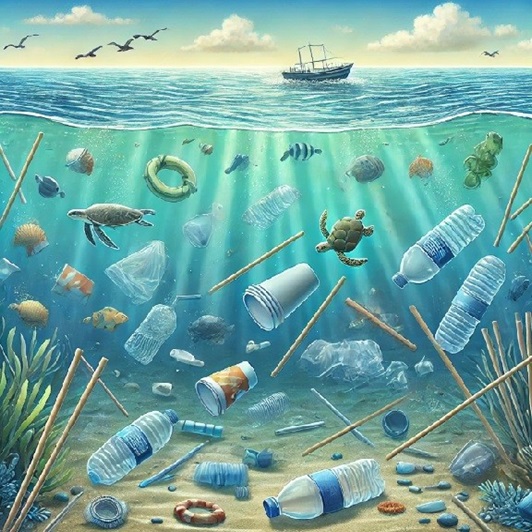Researchers at WHOI have conducted a study comparing the degradation rates of various straw materials in marine conditions, revealing that biodegradable options like cellulose diacetate (CDA) and polyhydroxyalkanoates (PHA) degrade faster than traditional plastics.
Researchers Determine the Lifetimes of Commercial Drinking Straws in the Coastal Ocean
A recent study by WHOI has demonstrated that some biodegradable straws degrade up to 50% within 16 weeks in marine environments. This finding offers a sustainable alternative to traditional plastics, potentially reducing ocean pollution.
The Prevalence of Plastic Straws as Marine Litter
Straws are among the most common plastic waste items found along coastlines. With the increase in plastic product consumption and disposal, scientists and manufacturers are striving to develop alternative materials that perform effectively without contributing to environmental pollution.
Not all plastics are created equal. Different manufacturers use various formulations of base polymers, such as polylactic acid (PLA) and polypropylene (PP), and chemical additives. These differences mean that plastics behave differently in the environment and break down at varying rates. New materials, such as cellulose diacetate (CDA), a polymer derived from wood pulp, are being explored by Woods Hole Oceanographic Institution (WHOI) scientists to determine how long straws last in the ocean.
Plastic Straw Marine Litter
Straws are a common source of marine litter. Researchers highlight the need for understanding the longevity of plastics in the ocean and advocate for moving away from their use.

Testing and Results on Straw Degradation
In a paper published in ACS Sustainable Chemistry & Engineering, WHOI scientists Collin Ward, Bryan James, Chris Reddy, and Yanchen Sun compared the degradation rates of different plastic and paper drinking straws in coastal ocean conditions. They partnered with bioplastic manufacturer Eastman, who provided funding, materials, and coauthored the study.
Promising Developments in Biodegradable Straws
The researchers suspended eight types of straws in a tank of continuously flowing seawater from Martha’s Vineyard Sound, Massachusetts. This setup controlled environmental variables to mimic natural marine conditions. The straws were monitored for degradation over 16 weeks, and microbial communities on the straws were characterized.
“My interest has been to understand the fate, persistence, and toxicity of plastic and how we can use that information to design next-generation materials that are better for people and the planet,” James said. “We have a unique capability to replicate ocean conditions on land, providing a controlled environment with natural seawater.”
They tested straws made of CDA, PHA, paper, PLA, and PP. CDA, PHA, and paper straws degraded by up to 50%, projecting environmental lifetimes of 10-20 months in coastal oceans. PLA and PP straws showed no measurable signs of degradation.
Environmental Impact of Straw Materials
The scientists compared two CDA straws—one solid and one foam, both from Eastman. The foam straw, designed to increase surface area and accelerate breakdown, degraded 184% faster than its solid counterpart, resulting in a shorter projected environmental lifetime than paper straws.
Industry and Environmental Perspectives
“This study is valuable for straw manufacturers by providing data to inform material selection and reassures that CDA-based straws won’t contribute to persistent plastic pollution,” said Jeff Carbeck, Eastman’s Vice President of Corporate Innovation.
The Persistent Challenge of Plastics
Science supports a shift away from conventional plastics. Plastic pollution harms humans and ecosystems, and the plastic industry significantly contributes to climate change. Identifying new materials that break down if they enter the environment is crucial.
“While some push to move away from plastics, the reality is they are here to stay. We aim to minimize their environmental impact,” Ward said.
Collaboration for Sustainable Solutions
“We recognized the importance of testing our CDA-based products’ marine degradation but lacked the resources,” Carbeck said. “Collaborating with WHOI showcases the power of industry-academia partnerships in advancing shared goals.”
The research team found unique microbial communities on degrading straws, suggesting native microbes are responsible, while non-biodegradable straws persisted.
“Our understanding of plastic pollution’s impact on ocean health is uncertain, partly due to unknown long-term fates of these materials,” Ward said. The team plans to continue measuring plastic degradability to guide future industry directions.
“There are advantages to partnering with material manufacturers, including access to analytical facilities and materials knowledge. We aim to optimize their products for environmental degradation,” Ward said.
Also read: Insights from the Cambrian SPICE Event: Understanding Oceanic Oxygen Collapse 500 Million Years Ago
Key Takeaways
Not all plastics are equal; some last longer in the ocean. WHOI scientists have quantified the environmental lifetimes of various plastic goods. Their study found CDA, PHA, and paper straws degraded up to 50% in 16 weeks, aided by unique microbial communities. A foamed CDA prototype straw degraded faster than solid straws. Science supports moving away from persistent plastics and ensuring new materials break down if they leak into the environment.
Reference: “Strategies to Reduce the Environmental Lifetimes of Drinking Straws in the Coastal Ocean” by Bryan D. James, Yanchen Sun, Mounir Izallalen, Sharmistha Mazumder, Steven T. Perri, Brian Edwards, Jos de Wit, Christopher M. Reddy, and Collin P. Ward, 30 January 2024, ACS Sustainable Chemistry & Engineering.
DOI: 10.1021/acssuschemeng.3c07391
Other Sources: Researchgate






